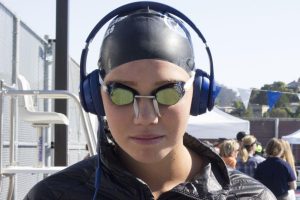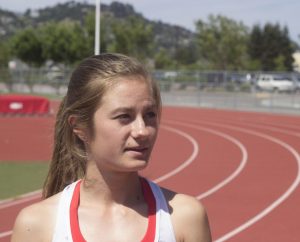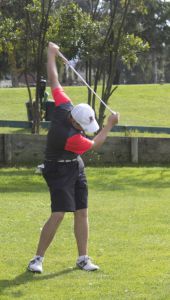People mill about the track, parents pack the stands, and athletes walk across the field to their events.

Standing behind the starting line is senior Mary Monda Oewel, shaking her legs and taking a few deep breaths. The world around her begins to disappear.
“I tell myself I am doing this because I love it and tell myself I can do it. I just let everything else fade away and think about what I am about to do,” Oewel said.
Up on the pitching mound, junior Zack Cohen looks down. He picks up a handful of dirt and hits the top of his cleat on the ground at the start of the inning.
Standing on the edge of the volleyball court, junior Lily Barber holds hands with her teammates as the national anthem plays over the loudspeaker.
A slight breeze blows as senior Yoshio Boris picks up his club, practices a swing, and moves to stand over the tee.
Earphones over her swim cap, senior Emma McCarthy swings her arms in her warm-up jacket and shakes her legs all the way down to her pink Nike frees. She stares at the pool as she listens to her pre-race playlist, then removes her clothes, splashes herself with water, and swings her arms.
Oewel crouches at the starting line waiting for the gun to fire. Cohen prepares to pitch. Barber waits for the first serve. Boris begins to swing. McCarthy climbs on the block.
All five of these top varsity athletes are preparing themselves physically and mentally for an important race or event.
The Bark talked to five different athletes and one sports psychologist to explain how mental state affects performance and how athletes can actively create the best mindset for themselves.
Local doctor Joan Steidinger of Power Zone PHD works with young athletes and believes that an athlete’s psychology greatly affects their performance: Negative thoughts and emotions correlates to an increase in anxiety. Author of the book “Sisterhood in Sports: How Female Athletes Collaborate and Compete,” Dr. Steidinger also focuses on how women work together on a team.
“There are five factors to keep in mind that are important. I put it under the acronym of POWER,” Dr. Steidinger said. “‘P’ stands for positive thoughts. ‘O’ stands for operating with confidence. ‘W’ is working with motivation. ‘E’ is energizing your focus and concentration. ‘R’ is rehearsing visually either the actual meet or game.”
Pre-race Routines
Many athletes feel nervous and excited before a game or race, and according to Dr. Steidinger, these nerves can help performance.
The easiest way to gain confidence before a race is to do the same thing every time to prepare, Dr. Steidinger said. She encourages athletes to find a routine that helps them warm up and reduce their anxiety.
“I also recommend that people figure out a pre-event or race or game routine to have for them that helps them get grounded and centered,” Dr. Steidinger said.
McCarthy has a very specific routine she follows before each race.
“The things that I do behind the blocks I’m pretty superstitious about,” McCarthy said. “If I do them the way I am supposed to do, then everything will be fine and okay. If I have my pink shoes, I will be okay.”
Before a big meet, McCarthy warms up about 1500 yards in the pool. Then she gets out of the pool to stretch, takes her inhaler 30 minutes before her race, and eats three ShotBloks 15 minutes before her race. About eight minutes before her race, McCarthy lines up behind the starting blocks and listens to “Uptown Funk.”

“When the heat before me is starting the last 100 of their race, I take all my stuff off and always do the same thing with my feet and crack my toes by stepping on them and folding them over my feet,” McCarthy said. “Then I go up to the pool and splash myself with water. I do arm swings and then slap my muscles a ton up and down my legs. I then get up on the blocks and do this clapping thing and slap my legs one more time and then go.”
Oewel also has a warm up and pre-race routine that helps her feel confident.
She begins preparing for her race by eating specific foods at the same time each day before a race. For breakfast, she has oatmeal, and for lunch she has a turkey and avocado sandwich.
Oewel then begins warming up an hour before the meet by running slowly for 15 minutes and then doing stretches and strides.
Right before the race, she shakes out her legs and lets out a few yawns.
“I normally take a big deep breath and try and get out all the splits and times I want to run. I just think about doing it for the team or running as hard as I can,” Oewel said.
Not every athlete has as elaborate or specific of a routine as McCarthy or Oewel––some have smaller pre-game actions that boost confidence.
Barber said each volleyball player has their own short routine they do with the ball before each serve so that their serve is uniform. She bounces the ball three times and then hits it with her serving hand.
Cohen said he does a routine before each inning to get himself mentally prepared to pitch. He looks down, throws the ball to the catcher, then picks up some dirt and digs the top of his cleat into the ground. He always gets the ball from third base and throws it to second to warm up.
“It gets me into a rhythm and I really like it,” Cohen said. “Once I get out there I don’t really have a mood, I have more of mindset to pitch well and to perform well for the team.”
Cohen mentioned that preparing for the game even starts the night before when the whole team gets together to clean their cleats.
“As you are cleaning your cleats, you should be visualizing what you’re trying to do the next day and just thinking about the game,” Cohen said.
Visualizing
Mentally simulating competition can be extremely beneficial for athletes when done correctly, Dr. Steidinger said.
“The visualizing takes away the element of surprise because volleyball is a unique sport where every single play is different,” Barber said.
The night before a big meet, Oewel visualizes her race as she falls asleep.
“It prepares me for what I am about to do,” she said. “It is nice to have prepared specifically what you are going to tell yourself at specific points in your race to get yourself to go.”
For visualizing to be effective, Dr. Steidinger said it is beneficial to think about being somewhere calming. For swimmers, she recommends the bay, and for runners, she recommends a peaceful trail.
Oewel said that it is easier for her to manage her nerves when she runs cross country than when she runs track and field.
“I think it is the fact that you are going around a track,” Oewel said. “You are not in a peaceful beautiful area. You are on the track with people all around you, yelling at you.”
However, Dr. Steininger said that visualization can be detrimental to athletes with anxiety.
“People who have too much anxiety, when they try and visualize a meet, it tends to raise their anxiety. Instead, think about ‘I have a lot of confidence,’ ‘I’m motivated,’ ‘I’ve worked really hard for this,’” she said.
Negative thoughts
According to Dr. Steidinger, there is a correlation between negative thoughts and negative outcomes.
“What [athletes] need to learn to do is to produce positive thoughts before an event or game,” Dr. Steidinger said. “An example of a positive thought might be, ‘I’m fully trained’ or ‘I’m a skilled player.’ Have them think about what they do right versus wrong.”
Senior varsity golfer Yoshio Boris finds that being mentally present is the key to performing well.
“You can’t let one bad shot get in your head and ruin your whole round. The worst thing is not having confidence when you are standing over the ball,” Boris said.
Oewel said although she knows how to replace negative thoughts with positive ones during a race, she sometimes finds it difficult.
She recalled a cross country season race where her confidence was low, and she was not running the race for herself, but was instead caught up in beating a teammate.
“Because I had a bad workout the week before, and I was really down about it, I went into the race not just trying to do my best,” Oewel said. “That was not the right mindset to go into it. I think that a lot of it was me going into the situation afraid of not performing well.”
Competition among teammates can cause anxiety, according to Dr. Steidinger.
When Barber was competing for playing time on the court with one of her teammates, the situation affected her performance, and she went to talk to Dr. Steidinger.
“I just kept thinking to myself, ‘Why am I not playing?’ I was kind of just a confidence downer,” Barber said. “[Dr. Steidinger] helped me think of strategies during the game of what to say, little things that will calm me down immediately.”
Flow
When athletes are in their best mindset, pain seems to fade away, Dr. Steidinger said.
“When people are really into the flow when they are doing their event, they are not thinking about it,”

Dr. Steidinger said. “They are gliding along and it feels effortless. They are probably performing the best they have ever performed.”
When athletes are in the “zone,” all the physical and mental abilities cohere.
“Their thought habits, their confidence, their motivation, their focus, and they are imagining themselves in the race, and all the power elements peak together,” Dr. Steidinger said.
Oewel says she feels powerful during a perfect race.
“I get out there and it is amazing. I do not even tell myself I have to do it. It just happens. Then I pass the next person in front of me. I like to think about it as devouring them. You just pass them, then the next and the next person, and you feel so good,” Oewel said.
When she is in the flow of a game, Barber is not distracted by the environment around her.
“If I am not in the zone, I get distracted by something in the crowd. I will look over to see who’s watching,” Barber said. “The flow is when you don’t see any of those people, and even if you do it does not affect anything and it doesn’t motivate you because what should motivate you is your own internal thoughts.”

















